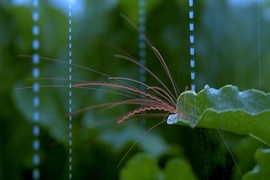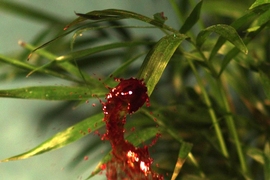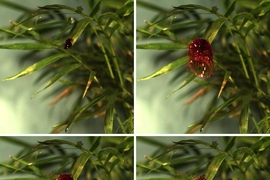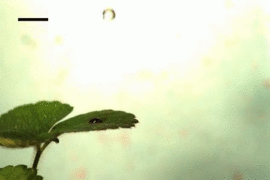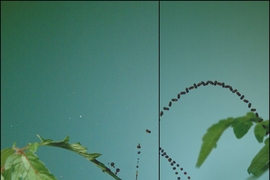Farmers have long noted a correlation between rainstorms and disease outbreaks among plants. Fungal parasites known as “rust” can grow particularly rampant following rain events, eating away at the leaves of wheat and potentially depleting crop harvests.
While historical weather records suggest that rainfall may scatter rust and other pathogens throughout a plant population, the mechanism by which this occurs has not been explored, until now.
In a paper published in the Journal of the Royal Society Interface, a team from MIT and the University of Liege, in Belgium, presents high-speed images of raindrops splashing down on a variety of leaves coated with contaminated fluid. As seen in high resolution, these raindrops can act as a dispersing agent, in some instances catapulting contaminated droplets far from their leaf source.
The researchers observed characteristic patterns of dispersal, and found that the range of dispersal depends on a plant’s mechanical properties — particularly its compliance, or flexibility.
Lydia Bourouiba, the Esther and Harold E. Edgerton Career Development Assistant Professor of Civil and Environmental Engineering at MIT, says understanding the relationship between a plant’s mechanical properties and the spread of disease may help farmers plant more disease-resistant fields.
“We can start thinking of how to smartly reinvent polyculture, where you have alternating species of plants with complimentary mechanical properties at various stages of their growth,” says Bourouiba, who is a senior author of the paper. “Polyculture is an old concept if you look at native cultures, but this is one way to scientifically show that by alternating plants in one field, you can mechanically and naturally reduce the range of transmission of a pathogen during rainfall.”
Tracking the fluid dynamics of outbreak
In their paper, Bourouiba and Tristan Gilet, of the University of Liege, first addressed a widely held assumption: that pathogens coat leaves in a thin film.
The team ran experiments with dozens of types of common foliage, including ivy, bamboo, peppermint, and banana leaves. They conducted hundreds of experiments for each type of foliage, using 30 examples of real plant foliage and 12 artificially engineered materials. In initial trials, the researchers simulated rainfall by running water through a container pricked with tiny holes. The container was suspended several meters in the air, high enough for drops to reach terminal velocity — the speed of an actual raindrop upon impact.
The researchers captured the sequence of events as raindrops hit each leaf, using high-speed videography at 1,000 frames per second. From these images, Bourouiba and Gilet noted that as water fell, leaves were unable to support a thin film, instead forming drops on their surface. The team concluded that pathogens, in turn, must rest as droplets — not film — on a leaf’s surface.
“That can initially seem like a small difference, but when you look at the fluid dynamics of the fragmentation and resulting range of contamination around an infected leaf, it actually changes a lot of the dynamics in terms of the mechanism by which [pathogens] are emitted,” Bourouiba says.
To observe such dynamic differences, the team first simulated rainfall over a flat surface coated with a thin film. When a droplet hit this surface, it launched a crown-like spray of the filmy substance, though most of the spray stayed within the general vicinity. In contrast, the team found that raindrops that splashed onto leaves covered with droplets, rather than a film, launched these drops far and wide.
Historical weather records suggest that rainfall may scatter rust and other pathogens throughout a plant population, the mechanism by which this occurs has not be explored, until now.
From crescent moons to catapults
To examine the effect of raindrops on surface drops in more detail, the researchers performed a separate round of experiments, in which they dotted leaves with dyed water — a stand-in for pathogens. They then created a setup to mimic one single drop of rain, using lasers to delicately calibrate where on the leaf a drop would fall.
From these experiments, Bourouiba and Gilet observed two main patterns of dispersal: a crescent-moon configuration, in which a raindrop flattens upon impact, sliding underneath the dyed droplet and launching it up in an arc, similar to the shape of a crescent moon; and inertial detachment, where a raindrop never actually touches a dyed droplet, but instead pushes the leaf down, causing the dyed droplet to slide downwards, then catapult out — a consequence of the inertia of the leaf as it bounces back up.
After capturing hundreds of raindrop impacts on a range of leaf types, Bourouiba and Gilet realized that whether a droplet assumes a crescent-moon or inertial detachment configuration depends mainly on one property: a leaf’s compliance, or flexibility. They found that in general, the floppier a leaf, the less effective it was at launching a wide arc, or crescent-moon of fluid. However, at a certain flexibility, the crescent-moon pattern morphed into one of inertial detachment, in which fluid, in the form of larger drops than what the crescent moon can produce, was flung further from the leaf.
From their observations, the researchers developed a theoretical model that quantitatively captures the relationship between a leaf’s flexibility, the fragmentation of the fluid, and its resulting pattern of raindrop-induced dispersal. The model, Bourouiba says, may eventually help farmers design fields of alternating crops. While the practice of polyculture has traditionally relied on reducing the spread of disease by alternating plants with varying resistance to pathogens, Bourouiba says the intrinsic mechanical properties — not biological immunology — of plants could themselves help contain the spread of disease.
“If this were done optimally, ideally you could completely cut the spread to just one neighboring plant, and it would die there,” Bourouiba says. “One plant could play the role of a shield, and get contaminated, but its mechanical properties would not be sufficient to project the pathogen to the next plant. So you could start reducing the efficacy of spread in one species, while still using agricultural space effectively.”
Don Aylor, an emeritus scientist of plant pathology and ecology at the Connecticut Agricultural Experiment Station in New Haven, Conn., says Bourouiba’s results may be particularly useful in tamping down disease in small plant populations.
“This could help set separation distances for crops of small plants, such as strawberries, that are usually planted in close proximity,” says Aylor, who did not contribute to the study. “The farmer would also have to consider the effect of splashing on plastic mulch often used in such crops. In summary, this is a nice study and introduces some findings that are certainly worth following up on.”
